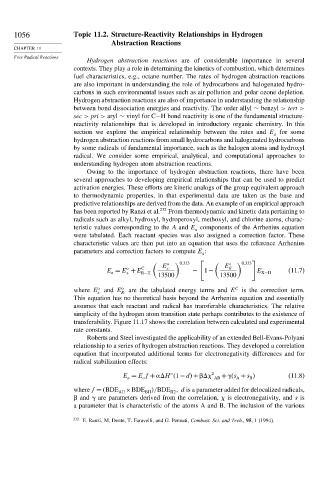Page 1072 - Advanced Organic Chemistry Part A - Structure and Mechanisms, 5th ed (2007) - Carey _ Sundberg
P. 1072
1056 Topic 11.2. Structure-Reactivity Relationships in Hydrogen
Abstraction Reactions
CHAPTER 11
Free Radical Reactions
Hydrogen abstraction reactions are of considerable importance in several
contexts. They play a role in determining the kinetics of combustion, which determines
fuel characteristics, e.g., octane number. The rates of hydrogen abstraction reactions
are also important in understanding the role of hydrocarbons and halogenated hydro-
carbons in such environmental issues such as air pollution and polar ozone depletion.
Hydrogen abstraction reactions are also of importance in understanding the relationship
between bond dissociation energies and reactivity. The order allyl ∼ benzyl > tert >
sec > pri > aryl ∼ vinyl for C−H bond reactivity is one of the fundamental structure-
reactivity relationships that is developed in introductory organic chemistry. In this
section we explore the empirical relationship between the rates and E for some
a
hydrogen abstraction reactions from small hydrocarbons and halogenated hydrocarbons
by some radicals of fundamental importance, such as the halogen atoms and hydroxyl
radical. We consider some empirical, analytical, and computational approaches to
understanding hydrogen atom abstraction reactions.
Owing to the importance of hydrogen abstraction reactions, there have been
several approaches to developing empirical relationships that can be used to predict
activation energies. These efforts are kinetic analogs of the group equivalent approach
to thermodynamic properties, in that experimental data are taken as the base and
predictive relationships are derived from the data. An example of an empirical approach
has been reported by Ranzi et al. 232 From thermodynamic and kinetic data pertaining to
radicals such as alkyl, hydroxyl, hydroperoxyl, methoxyl, and chlorine atoms, charac-
teristic values corresponding to the A and E components of the Arrhenius equation
a
were tabulated. Each reactant species was also assigned a correction factor. These
characteristic values are then put into an equation that uses the reference Arrhenius
parameters and correction factors to compute E :
a
o 0 333 o 0 333
E E R
C
o
E = E +E R−H x· − 1− E X−H (11.7)
a
x·
13500 13500
where E o and E o are the tabulated energy terms and E C is the correction term.
x· R·
This equation has no theoretical basis beyond the Arrhenius equation and essentially
assumes that each reactant and radical has transferable characteristics. The relative
simplicity of the hydrogen atom transition state perhaps contributes to the existence of
transferability. Figure 11.17 shows the correlation between calculated and experimental
rate constants.
Roberts and Steel investigated the applicability of an extended Bell-Evans-Polyani
relationship to a series of hydrogen abstraction reactions. They developed a correlation
equation that incorporated additional terms for electronegativity differences and for
radical stabilization effects:
o
E = E f + H 1−d
+ 2 AB + s +s
(11.8)
A
a
o
B
where f = BDE AH ×BDE
/BDE d is a parameter added for delocalized radicals,
BH
H2
and are parameters derived from the correlation, is electronegativity, and s is
a parameter that is characteristic of the atoms A and B. The inclusion of the various
232
E. Ranzi, M. Dente, T. Faravelli, and G. Pennati, Combust. Sci. and Tech., 95, 1 (1994).

